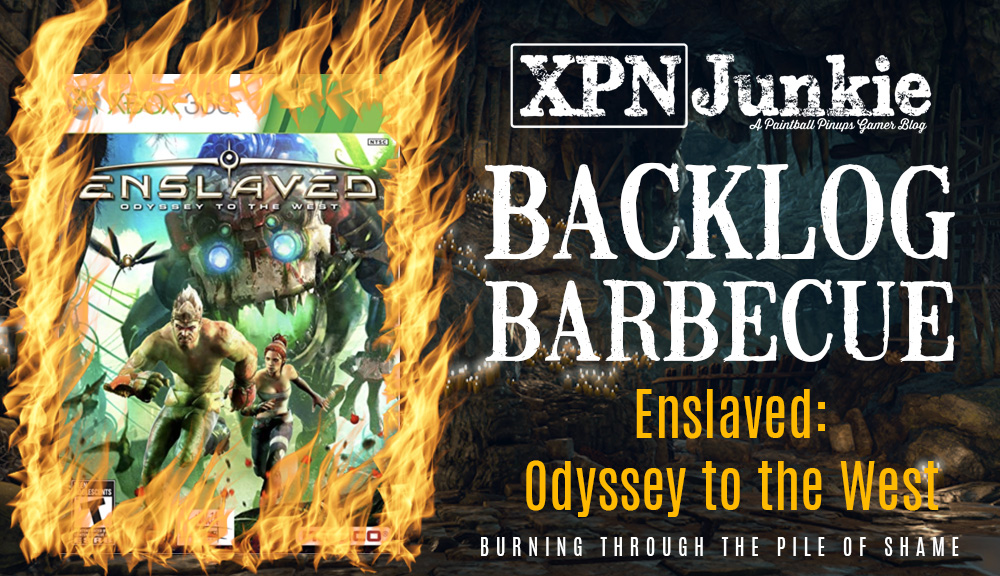Hello, and welcome back to XPNJ’s Backlog Barbecue, where we take a game from the ‘log and throw it on the fire, and have a word about it as it burns. (As always, if you would rather read, or just straight up hate the sound of my voice, a written version of this video can be found at the link below).
Today I get to remove Enslaved: Odyssey to the West from the ever-growing list of games I really, really need to finish.
And it’s about damn time, too. Enslaved is a gem of the Xbox 360 / PS3 era, and one of the most memorable games that Ninja Theory ever produced (and that’s saying something). Also, playing it for the first time in 2022, I have to say, there are some similarities to another game that just recently got a sequel, and I can’t help but raise an eyebrow and compare the two. But more on that in a minute.
Enslaved: Odyssey to the West is a somewhat obvious adaptation of the Chinese novel Journey to the West, but the twist being that the main character, Monkey, is tethered, both literally and figuratively, to a female character named Trip. Monkey is human, but with characteristics and an appearance that is very ape-like, with a sash that hangs from his waist that, when jumping around, kinda looks like a tail. I’m pretty sure this is intentional. Monkey is enslaved by Trip through an act of desperation, as she needs to get back to her village and is, essentially, forcing Monkey to escort her and keep her alive. If she dies, he dies. It’s an interesting take on your typical escort mission setup, and I have to admit, I kinda groaned when I realized that I was going to have to basically hold her hand as I traversed the post-apocalyptic wasteland.
In reality, my fears were unfounded, as Trip for the most part is self-sufficient, handles the traversal fairly well on her own, and can be issued commands to help Monkey get past obstacles. You still need to protect her, but you are protecting her from the hazards, instead of protecting her from herself, if that makes sense. i.e. she’s not going to see a landmine, then proceed to step on said landmine. This was a obstacle early in the game, and I appreciated that Ninja Theory realized that would be a major pain in the ass and worked in a gameplay mechanic to get around it.
The journey through the post-apocalyptic New York is filled with cinematic camera angles and exciting set-pieces, very reminiscient of games like Uncharted and the old God of War games, where the environment is as much a character in the game as Monkey or Trip, and the scale of the area or situation is depicted from interesting perspectives to make it much more exciting than, say, just side-scrolling along a building. Playing this really did make apparent, in a bad way, that games really just don’t attempt stuff like this anymore, and that’s a shame. Even the God of War 2018 only had two of those epic sequences that the series was known for.
That’s not to say everything is great. The game is a platformer first and a brawler second, and unfortunately that shows later in the game when you’re forced to fight several enemies at once. The combat is really simple and kinda bad, to be honest, and that’s a really weird thing to say considering they’re such a talented developer. In 2010, though, they had really only done two other games, Kung Fu Chaos and Heavenly Sword, the latter of which was fun, but similarly simple when it came to combat. They didn’t really start to show their fighting chops until DmC: Devil May Cry.
But here, the camera is a bit too tight in on Monkey as he’s surrounded by enemies, and the lack of a lock-on feature can see the player repeatedly miss his charged attack as the robots are constantly moving from side to side and attacking from all angles. I feel like I am fighting the controls as much as I’m fighting slavers, and as enjoyable as the rest of the game is, it just kinda makes this weaker aspect stand out that much more. There were a few fights in particular where the quarters were a bit tight and the camera just didn’t know what to do. Those fights were problematic at best and downright aggravating at worst.
As a backlog title, this game finally crossed my television screen well after its hey-day, and sometimes that means the game I’m playing just hasn’t aged well. Thankfully that’s not the case here. Graphically, the game holds up really well. It was developed on Unreal Engine 3, and it shows, as the games of that time period usually had traits that were indicative of that particular engine. The texture pop-in wasn’t nearly as bad here as in other games, but that also could be because I was playing it on an Xbox Series S/X as opposed to a 360. If I had one complaint, it’s the framerate. On the Series S/X, via backward compatibility, the game still seemed to run at a locked 30 fps. When platforming and constantly swinging the camera around, that’s pretty rough. This might not be an issue if playing on a PC, but damn this game could’ve really benefitted from the FPS Boost initiative.
The platforming controls are a combination of good and bad, with some restrictive decisions being a lesser evil to what may have been a worse alternative. Allow me to explain. Monkey has to jump from ledges and platforms and rubble and old random pieces of infrastructure, and many times the camera angle is kinda awkward. We’ve all played those platformers where trying to decide which direction to push the analog stick when jumping from one ledge to another can be a hair-pulling experience. We’ve jumped off in random directions to our deaths, accidentally walked off ledges, etc etc. It’s annoying.
Ninja Theory’s answer to this is to make the platforming… um.. Sticky? The player can only jump toward another platform or grab-able object. Likewise, the player cannot accidentally walk Monkey off a ledge, but that also means that Monkey can’t walk off a ledge onto a lower ledge, without pushing the A button. This is great and all, but sometimes that A button requires a few presses before Monkey will do what you need him to do. Sometimes there are specific sections of the ledge where Monkey can drop from, and finding the sweet spot on that ledge can require a few taps before he actually does what you want him to do. It’s not a huge deal, and it’s definitely not as irritating as accidentally falling to your death would be, but it still managed to elicit a sigh and a growl from me on a few occasions.
As far as the story goes, Enslaved is surprisingly light on exposition. Something happened to the world at some point, and well, that’s all you need to know. There was a war of some kind, and since then, the mechs have taken over, with humans living in small communities and villages while hiding from not only the machines bent on annihilation, but also from slavers that have been systematically snatching up or eliminating everyone they come across.
The “slavers” are a vague and faceless antagonist throughout the game, only really seen once at the very beginning. After that, the mechs prove to be the main obstacle, but it’s never really clear if the mechs work for the slavers or if they’re just random psycho bots trying to kill all organic life.
Speaking of, because of the limited scope of the story, it leaves a lot of questions unanswered. Throughout the entirety of the game, there doesn’t seem to be much organic life, at all. What do the people in the wasteland eat? And speaking people, where are they? Monkey mentions that he travels from place to place trading with the people he comes across, but there are no signs of civilization anywhere in the game. Have they all been taken? The only other living person they come across is Pigsy, a portly little ugly dude that, appropriately, looks like a pig. But again, WHAT DOES HE EAT?? Some kind of hint, like a hydroponics shelf with some plants, could have easily answered this question, but the devs apparently weren’t worried about explaining any of that. Likewise, the ending, which I won’t spoil here, might have been novel back in 2010, but has been done a couple times since then. It’s a bit abrupt, and while not being a cliffhanger, does leave the story pretty open-ended. It’s unknown if Ninja Theory ever intended to create a sequel, but with the Horizon series on Playstation essentially taking this exact setting and cranking it up to 10, along with the publishing rights apparently resting in Namco’s questionable hands, the likelihood of that happening are close to none.
CLOSING THOUGHTS
I had to stop and appreciate the fact that neither Monkey or Trip were annoying, awful characters. They could have easily made Monkey a super-macho, asshole type, and likewise Trip could’ve been a bratty, entitled pain in the ass, but the characters remained empathetic and likeable. Monkey understood the position he was in and accepted it. Not willingly, of course, but he left it at that. Trip was doing what she had to do to survive, and clearly showed guilt over putting him in that position. Top notch voice acting from Andy Serkis and Lindsey Shaw.
Trip never made Monkey dance. C’mon, you have a big burly chunk of muscle completely under your control, why not make him dance?
During a scene with an aquarium, Trip mentions how her village is entirely self-sufficient. When visiting said village, it’s clear they depend on wind power for electricity, but there are still no signs of agriculture anywhere. Interesting.
Horizon Zero Dawn draws some serious parallels here. I’m not saying they swiped a few ideas from Ninja Theory’s take, but I’m not saying they didn’t either. I can easily see what an Enslaved sequel could’ve looked like, had one released in the PS4/Xbox One generation (or later).
That about wraps it up for this edition of Backlog Barbecue. Hope to see you back next time, and thanks for checking out the channel. Until then, game on!





